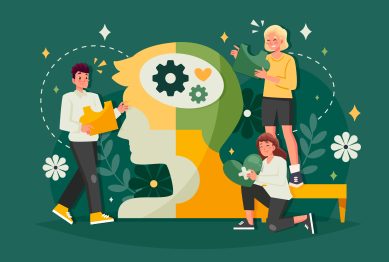In today’s fast-paced world, where work deadlines, social media, and constant distractions demand our attention, it’s easy to feel overwhelmed. Mental clutter builds up quickly, leaving us anxious and confused. This is where taking a mental step back can make all the difference. In the wellness space, the idea of pausing, reflecting, and stepping back from the noise has been gaining momentum as an essential practice to regain mental clarity and peace.
Mental clarity isn’t just a fleeting feeling; it’s a skill that can be cultivated with the right approach. In this article, we explore how taking a step back from your thoughts, emotions, and external pressures can help clear mental fog, improve decision-making, and restore a sense of inner peace.

The Power of Mental Reflection
Taking a mental step back to find clarity is rooted in mindfulness and self-reflection, practices that have gained popularity in recent years. These techniques involve slowing down, observing your thoughts, and intentionally deciding how to respond. When you step back, you create space to assess situations more objectively, making it easier to find solutions or let go of unimportant issues.
1. Mental Clarity through Mindfulness
Mindfulness is the practice of focusing on the present moment without judgment. By practicing mindfulness, we train ourselves to step back from the constant flow of thoughts. Rather than being swept up by emotional reactions, mindfulness allows us to observe thoughts and feelings, giving us the clarity to respond thoughtfully instead of reacting impulsively. Research shows that mindfulness can reduce stress, improve focus, and enhance well-being. A study in Psychological Science found that just a few minutes of mindfulness meditation can improve performance in high-pressure situations (Zeidan et al., 2010). Thus, taking a mental step back through mindfulness can provide clarity during uncertain moments.
2. Restoring Perspective through Reflection
Reflection involves looking back on your thoughts and experiences to evaluate them from a broader perspective. By stepping away from immediate emotions, you can analyze what truly matters, helping you make more informed decisions. Reflection can take many forms, such as journaling, meditation, or quiet contemplation. Research in Frontiers in Psychology shows that regular reflection improves self-awareness and emotional regulation, key factors for achieving mental clarity (Sedikides et al., 2016).
Incorporating mindfulness and reflection into daily life creates the space needed to manage stress, enhance focus, and make clearer decisions, ultimately leading to a calmer, more balanced mindset.
The Mental Step Back: Practical Techniques for Clarity
Taking a mental step back is a deliberate practice aimed at reducing mental clutter and gaining clarity. Here are some practical ways to implement this in your daily life:
1. Pause and Breathe
When your mind races, take a few deep breaths. Deep breathing activates the parasympathetic nervous system, calming your body and reducing stress. This simple technique helps shift your focus from chaos to the present moment, enabling clearer thinking.
2. Digital Detox
In a tech-driven world, constant notifications and digital distractions can overwhelm you. Taking a mental step back involves disconnecting from your devices for a while. Whether it’s an hour or a day, turning off your phone or stepping away from social media helps reduce mental clutter, allowing your brain to recharge and think more clearly.
3. Practice Gratitude
Focusing on the positive aspects of your life through gratitude can help shift your attention away from stressors. Studies show that regular gratitude practice improves mood, builds resilience, and promotes better mental health (Emmons & McCullough, 2003). Reflecting on what you’re grateful for fosters a positive outlook, making it easier to handle challenges with clarity.
4. Engage in Creative Activities
Creative outlets, such as painting, writing, or playing music, offer a mental break from routine thoughts. By engaging in creative activities, you give your mind space to reset, allowing clarity to emerge as your mind relaxes and focuses on the task.
5. Take a Walk in Nature
Spending time outdoors has been shown to reduce stress and improve mood (Barton & Pretty, 2010). A walk in a park or forest allows your mind to step back from daily demands, giving you the clarity you need to tackle challenges with a fresh perspective.
The Importance of Regular Reflection for Long-Term Clarity
While a single moment of stepping back can provide immediate relief, regularly incorporating these practices into your life can lead to sustained mental clarity. By making reflection, mindfulness, and other clarity-enhancing practices a part of your routine, you build resilience to stress and increase your ability to respond effectively to life’s challenges.
Regular self-reflection and mindfulness have been shown to reduce the likelihood of burnout and mental fatigue, which are common in today’s high-stress environments. In fact, a study in Psychological Health suggests that individuals who engage in regular mindfulness exercises experience less burnout and greater job satisfaction (Kabat-Zinn, 2003). This demonstrates how consistently taking a mental step back can create lasting benefits in both personal and professional life.
Conclusion
In our fast-paced world, taking a mental step back isn’t a luxury—it’s a necessity. By practicing mindfulness, reflection, and other mental clarity techniques, we create space for peace, insight, and better decision-making. These practices help us to step out of the noise, regain perspective, and approach life with renewed energy and clarity. The benefits are clear: those who take the time to pause and reflect are better equipped to handle stress, make informed choices, and navigate the complexities of daily life with a calm and focused mind.
Incorporating these practices into your routine doesn’t require drastic changes—just small, intentional steps. So, next time you feel overwhelmed, remember to take a mental step back. You may be surprised at how much clearer your path becomes.
References
- Zeidan, F., Johnson, S. K., Diamond, B. J., & David, Z. (2010). Mindfulness meditation improves cognition: Evidence of brief mental training. Psychological Science, 21(6), 1145–1152. Available at: https://journals.sagepub.com (Accessed: 1 August 2025).
- Sedikides, C., Gaertner, L., & Toguchi, Y. (2016). Self-reflection: A critical review of the role of reflection in promoting well-being. Frontiers in Psychology, 7, 1230. Available at: https://www.frontiersin.org (Accessed: 1 August 2025).
- Emmons, R. A., & McCullough, M. E. (2003). Counting blessings versus burdens: An experimental investigation of gratitude and subjective well-being in daily life. Journal of Personality and Social Psychology, 84(2), 377–389. Available at: https://psycnet.apa.org (Accessed: 1 August 2025).









